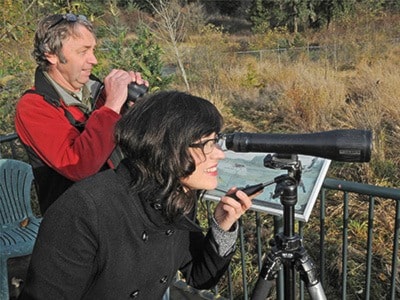“If I don’t show up at the office tomorrow, my unease meeting an unknown man in a place dubbed Viaduct Flats was warranted. I’ll keep my GPS turned on.”
This was the misplaced insurance policy I bought with a few key contacts the day before setting off on what is historically one of the riskiest activities known to adrenaline junkies the world over: birding.
When I arrived at the flats and met with my birding guide, it was instantly apparent that I should have saved any anxieties for the next time I find myself trapped at a groundbreaking ceremony.
Rick Schortinghuis, a member of the Victoria Natural History Society and Rocky Point Bird Observatory, met me at Viaduct Flats, a natural wetland within the Horticultural Centre of the Pacific, accessed off Interurban Road.
Binoculars around his neck, telescope under his arm and a coffee in hand, Schortinghuis welcomes me into the world of fall bird watching, one glimpse at a time. On a viewing platform just high enough above the marsh dense with cattails, he focuses his telescope on a cluster of wintering water fowl mid-pond. Four puttering gadwalls fill the sight.
“I just find it fascinating,” says Schortinghuis with an earnestness usually reserved for the under-10 set.
I’m not there yet, but I’m open.
The bright white markings of a hooded merganser – reminiscent of the classic pompadour do – pops into view. Criss-crossing the scene: American wigeons, ring-necked ducks and American coots, or “little brown ducks,” had you asked me last week. Each one – from the some-200 easily viewable bird species in the region – seems to express a little personality through its movements. There goes the wily American coot, waking up his neighbours with some rather abrupt morning moves. Maybe I’m projecting.
We trudge along beneath canopies of fir and cedar on a trail dotted with wild mushrooms. A curve in the course lands us at a lookout opposite our starting point. Back at the telescope, a handsome green-hooded gent glides into view. I’ve got this: mallard.
He’s gorgeous.
“If it wasn’t such a common bird, people would be wowed,” Schortinghuis says.
Student would have been happy simply gazing into the eyes of a mallard for the rest of the morning, yet sensei continues to point out all the species as they join us, rapidly now: common yellow throats, marsh wrens, Virginia warblers.
Animated song sparrows seem to swoop from the Disney archive reels and straight into our morning soundtrack.
Then the familiar caw I’ve always noted, but never identified cuts through the twittering.
“What’s that?” I ask and then imitate its call, poorly.
“Red-winged black bird.”
I would later learn the performance could have been spared in favour of Googling something like “most common bird in North America.”
“This is what excites me, seeing new birders see new birds for the first time,” Schortinghuis says. “Even when you see a bird for the second, third, tenth or hundredth time, it’s always a little bit different.”
Two eagles perch on a far off snag, an Oregon junco calls and the sparrows continue to chatter. On any typical walk around Victoria, you could observe about 50 such species. Between quiet asides on the continuing calls, the ravens or falcons near, Schortinghuis talks of the birding successes – the Anna’s hummingbird population that rose from about 10 pair in the ‘80s to today’s count of 1,000 through a nesting box program and the purple martins, which tell a similar survivor story, after having grown in population from about five pairs up to the quadruple-digit mark today.
Schortinghuis has led more than 300 birding field trips to date, including out-of-town birders in search of a local expert. He’s witnessed the excitement from international birders that landed on the Island when a citrine wagtail, which usually winters in South Asia, wound up in Courtenay last year. The uncommon sight would more than qualify as grounds to call the Rare Bird Alert hotline (yes, that does exist), but it’s also those everyday avian friends that can just as easily awaken an unexpected reaction in the observer.
Christmas Bird Count
Join the longest-running citizen’s science survey in its 114th year in Victoria on Dec. 14. Volunteer birders of all abilities continue on to Salt Spring Island and the Saanich Peninsula on Dec. 15, Sooke on Dec. 28 and Duncan on Jan. 1.
Guided birding walks
• Swan Lake: Birders meet Wednesdays and Sundays. Meet in the main parking lot at 9am.
• Tuesday birding group: Meets Tuesdays at 9am at the foot of Bowker Avenue in Oak Bay.
• Victoria Natural History Society’s Saturday birding group: posts the location of the Saturday walks on Fridays at vicnhs.bc.ca on the RBA transcript. The Victoria Natural History Society site also hosts an ongoing calendar of events.
